Fashion Haven's Accounting: Inventory and Bank Reconciliation Report
VerifiedAdded on 2023/06/04
|12
|1169
|140
Report
AI Summary
This report provides a comprehensive analysis of inventory management and bank reconciliation, focusing on Fashion Haven, a retail clothing shop in Australia. It differentiates between perpetual and periodic inventory systems, recommending the perpetual system for Fashion Haven due to its accuracy and automation. The report includes a calculation of ending inventory and cost of goods sold using FIFO, LIFO, and average cost methods, advocating for the FIFO method based on the company's context and profit maximization. Furthermore, it addresses bank reconciliation, presenting necessary adjustments and journal entries. The document is contributed by a student and available on Desklib, a platform offering a wide array of study resources.
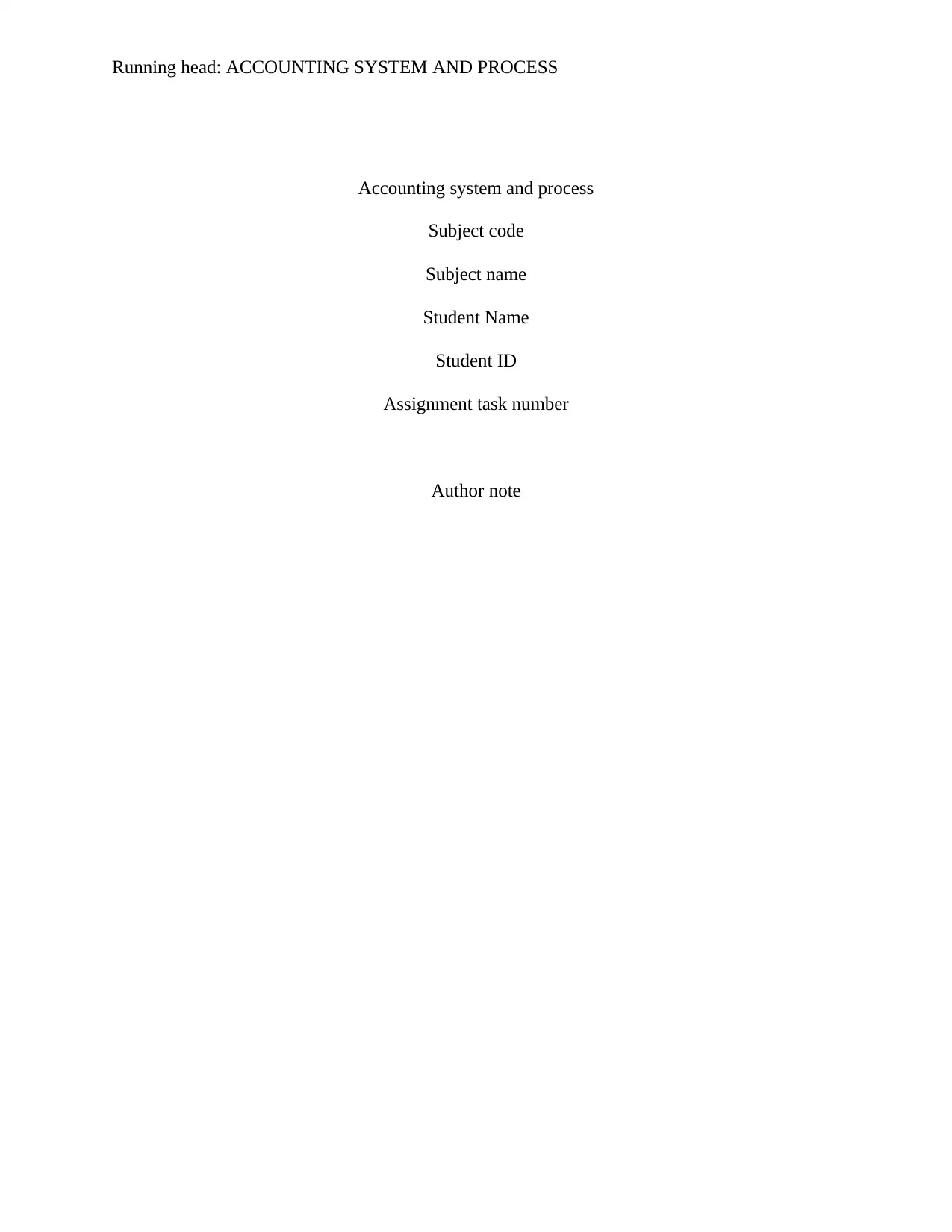
Running head: ACCOUNTING SYSTEM AND PROCESS
Accounting system and process
Subject code
Subject name
Student Name
Student ID
Assignment task number
Author note
Accounting system and process
Subject code
Subject name
Student Name
Student ID
Assignment task number
Author note
Paraphrase This Document
Need a fresh take? Get an instant paraphrase of this document with our AI Paraphraser
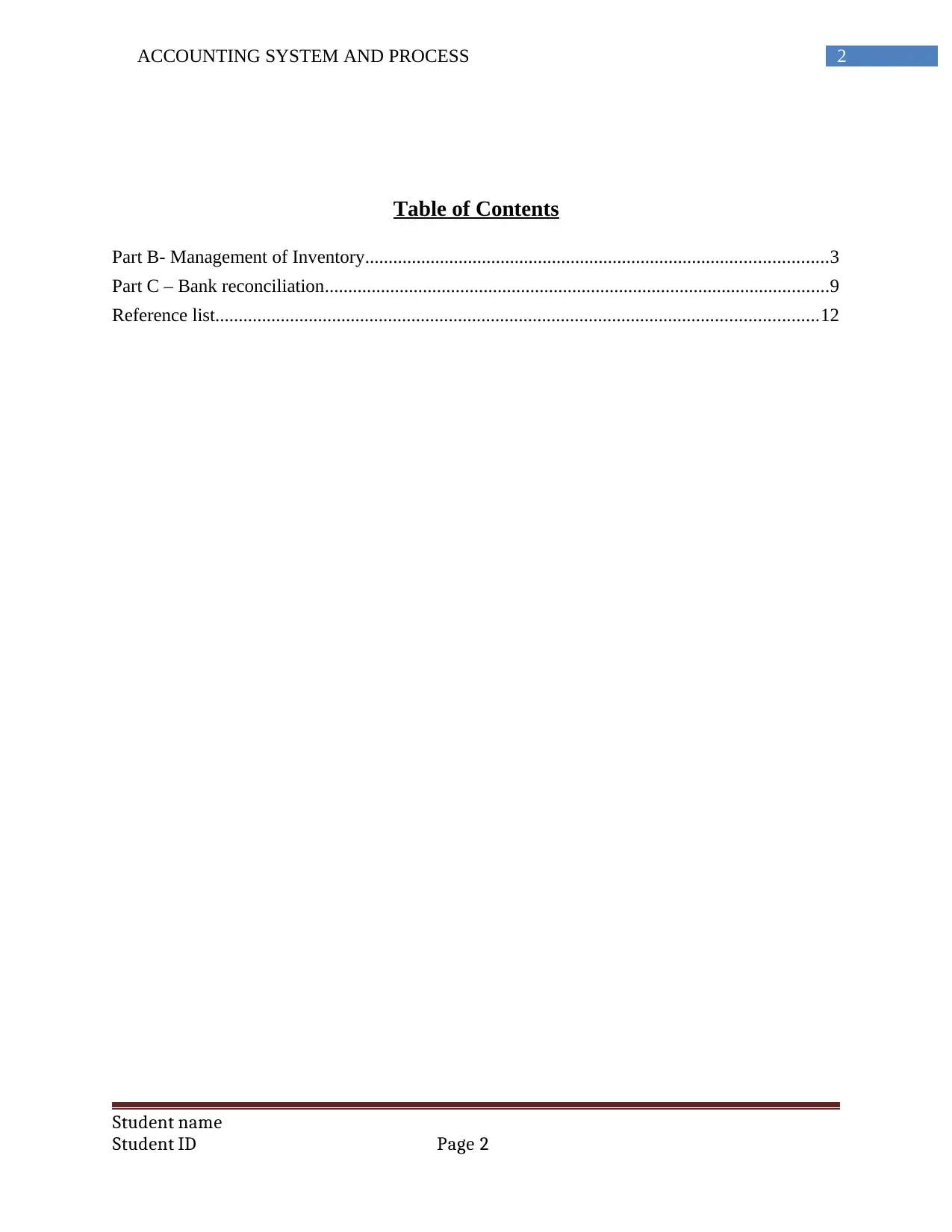
2ACCOUNTING SYSTEM AND PROCESS
Table of Contents
Part B- Management of Inventory...................................................................................................3
Part C – Bank reconciliation............................................................................................................9
Reference list.................................................................................................................................12
Student name
Student ID Page 2
Table of Contents
Part B- Management of Inventory...................................................................................................3
Part C – Bank reconciliation............................................................................................................9
Reference list.................................................................................................................................12
Student name
Student ID Page 2
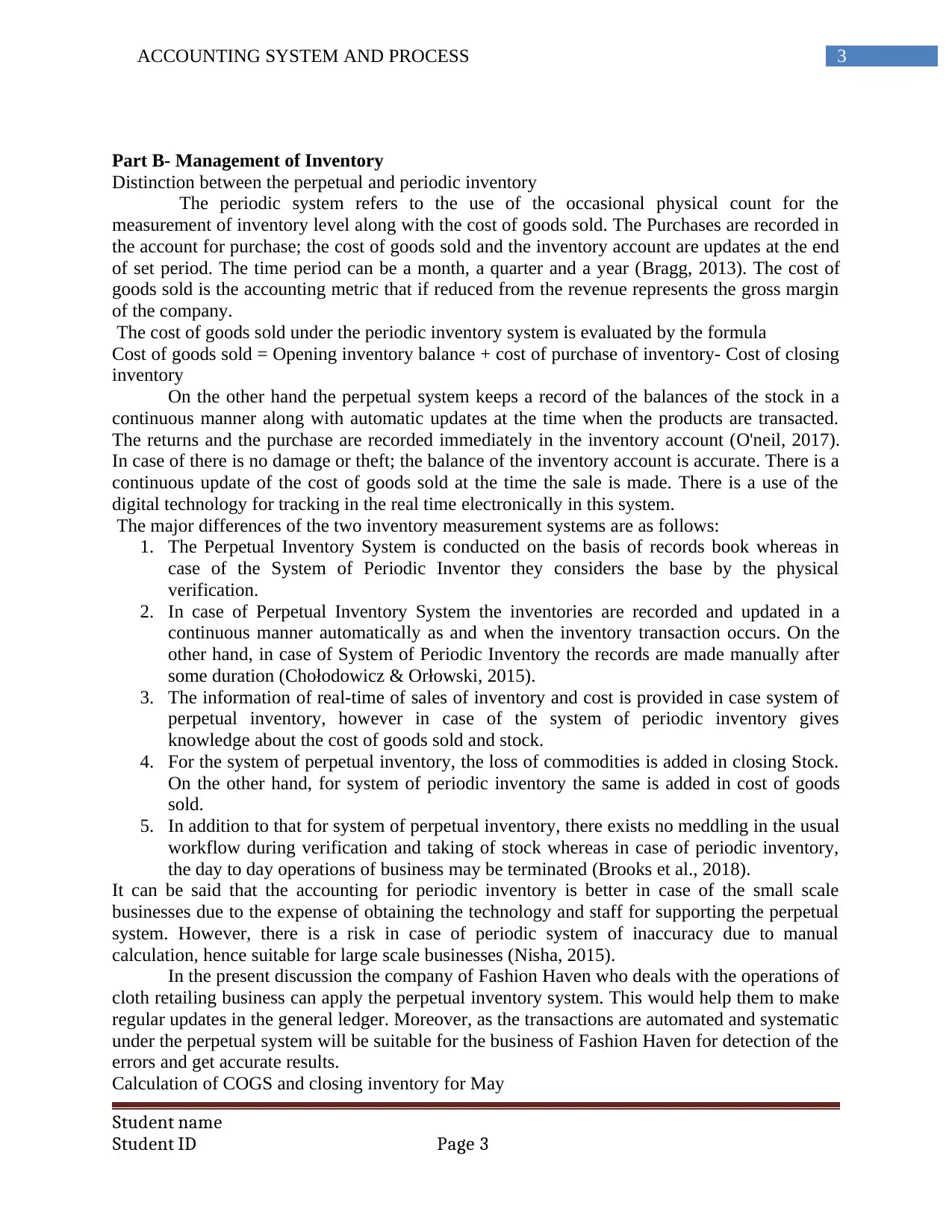
3ACCOUNTING SYSTEM AND PROCESS
Part B- Management of Inventory
Distinction between the perpetual and periodic inventory
The periodic system refers to the use of the occasional physical count for the
measurement of inventory level along with the cost of goods sold. The Purchases are recorded in
the account for purchase; the cost of goods sold and the inventory account are updates at the end
of set period. The time period can be a month, a quarter and a year (Bragg, 2013). The cost of
goods sold is the accounting metric that if reduced from the revenue represents the gross margin
of the company.
The cost of goods sold under the periodic inventory system is evaluated by the formula
Cost of goods sold = Opening inventory balance + cost of purchase of inventory- Cost of closing
inventory
On the other hand the perpetual system keeps a record of the balances of the stock in a
continuous manner along with automatic updates at the time when the products are transacted.
The returns and the purchase are recorded immediately in the inventory account (O'neil, 2017).
In case of there is no damage or theft; the balance of the inventory account is accurate. There is a
continuous update of the cost of goods sold at the time the sale is made. There is a use of the
digital technology for tracking in the real time electronically in this system.
The major differences of the two inventory measurement systems are as follows:
1. The Perpetual Inventory System is conducted on the basis of records book whereas in
case of the System of Periodic Inventor they considers the base by the physical
verification.
2. In case of Perpetual Inventory System the inventories are recorded and updated in a
continuous manner automatically as and when the inventory transaction occurs. On the
other hand, in case of System of Periodic Inventory the records are made manually after
some duration (Chołodowicz & Orłowski, 2015).
3. The information of real-time of sales of inventory and cost is provided in case system of
perpetual inventory, however in case of the system of periodic inventory gives
knowledge about the cost of goods sold and stock.
4. For the system of perpetual inventory, the loss of commodities is added in closing Stock.
On the other hand, for system of periodic inventory the same is added in cost of goods
sold.
5. In addition to that for system of perpetual inventory, there exists no meddling in the usual
workflow during verification and taking of stock whereas in case of periodic inventory,
the day to day operations of business may be terminated (Brooks et al., 2018).
It can be said that the accounting for periodic inventory is better in case of the small scale
businesses due to the expense of obtaining the technology and staff for supporting the perpetual
system. However, there is a risk in case of periodic system of inaccuracy due to manual
calculation, hence suitable for large scale businesses (Nisha, 2015).
In the present discussion the company of Fashion Haven who deals with the operations of
cloth retailing business can apply the perpetual inventory system. This would help them to make
regular updates in the general ledger. Moreover, as the transactions are automated and systematic
under the perpetual system will be suitable for the business of Fashion Haven for detection of the
errors and get accurate results.
Calculation of COGS and closing inventory for May
Student name
Student ID Page 3
Part B- Management of Inventory
Distinction between the perpetual and periodic inventory
The periodic system refers to the use of the occasional physical count for the
measurement of inventory level along with the cost of goods sold. The Purchases are recorded in
the account for purchase; the cost of goods sold and the inventory account are updates at the end
of set period. The time period can be a month, a quarter and a year (Bragg, 2013). The cost of
goods sold is the accounting metric that if reduced from the revenue represents the gross margin
of the company.
The cost of goods sold under the periodic inventory system is evaluated by the formula
Cost of goods sold = Opening inventory balance + cost of purchase of inventory- Cost of closing
inventory
On the other hand the perpetual system keeps a record of the balances of the stock in a
continuous manner along with automatic updates at the time when the products are transacted.
The returns and the purchase are recorded immediately in the inventory account (O'neil, 2017).
In case of there is no damage or theft; the balance of the inventory account is accurate. There is a
continuous update of the cost of goods sold at the time the sale is made. There is a use of the
digital technology for tracking in the real time electronically in this system.
The major differences of the two inventory measurement systems are as follows:
1. The Perpetual Inventory System is conducted on the basis of records book whereas in
case of the System of Periodic Inventor they considers the base by the physical
verification.
2. In case of Perpetual Inventory System the inventories are recorded and updated in a
continuous manner automatically as and when the inventory transaction occurs. On the
other hand, in case of System of Periodic Inventory the records are made manually after
some duration (Chołodowicz & Orłowski, 2015).
3. The information of real-time of sales of inventory and cost is provided in case system of
perpetual inventory, however in case of the system of periodic inventory gives
knowledge about the cost of goods sold and stock.
4. For the system of perpetual inventory, the loss of commodities is added in closing Stock.
On the other hand, for system of periodic inventory the same is added in cost of goods
sold.
5. In addition to that for system of perpetual inventory, there exists no meddling in the usual
workflow during verification and taking of stock whereas in case of periodic inventory,
the day to day operations of business may be terminated (Brooks et al., 2018).
It can be said that the accounting for periodic inventory is better in case of the small scale
businesses due to the expense of obtaining the technology and staff for supporting the perpetual
system. However, there is a risk in case of periodic system of inaccuracy due to manual
calculation, hence suitable for large scale businesses (Nisha, 2015).
In the present discussion the company of Fashion Haven who deals with the operations of
cloth retailing business can apply the perpetual inventory system. This would help them to make
regular updates in the general ledger. Moreover, as the transactions are automated and systematic
under the perpetual system will be suitable for the business of Fashion Haven for detection of the
errors and get accurate results.
Calculation of COGS and closing inventory for May
Student name
Student ID Page 3
⊘ This is a preview!⊘
Do you want full access?
Subscribe today to unlock all pages.

Trusted by 1+ million students worldwide
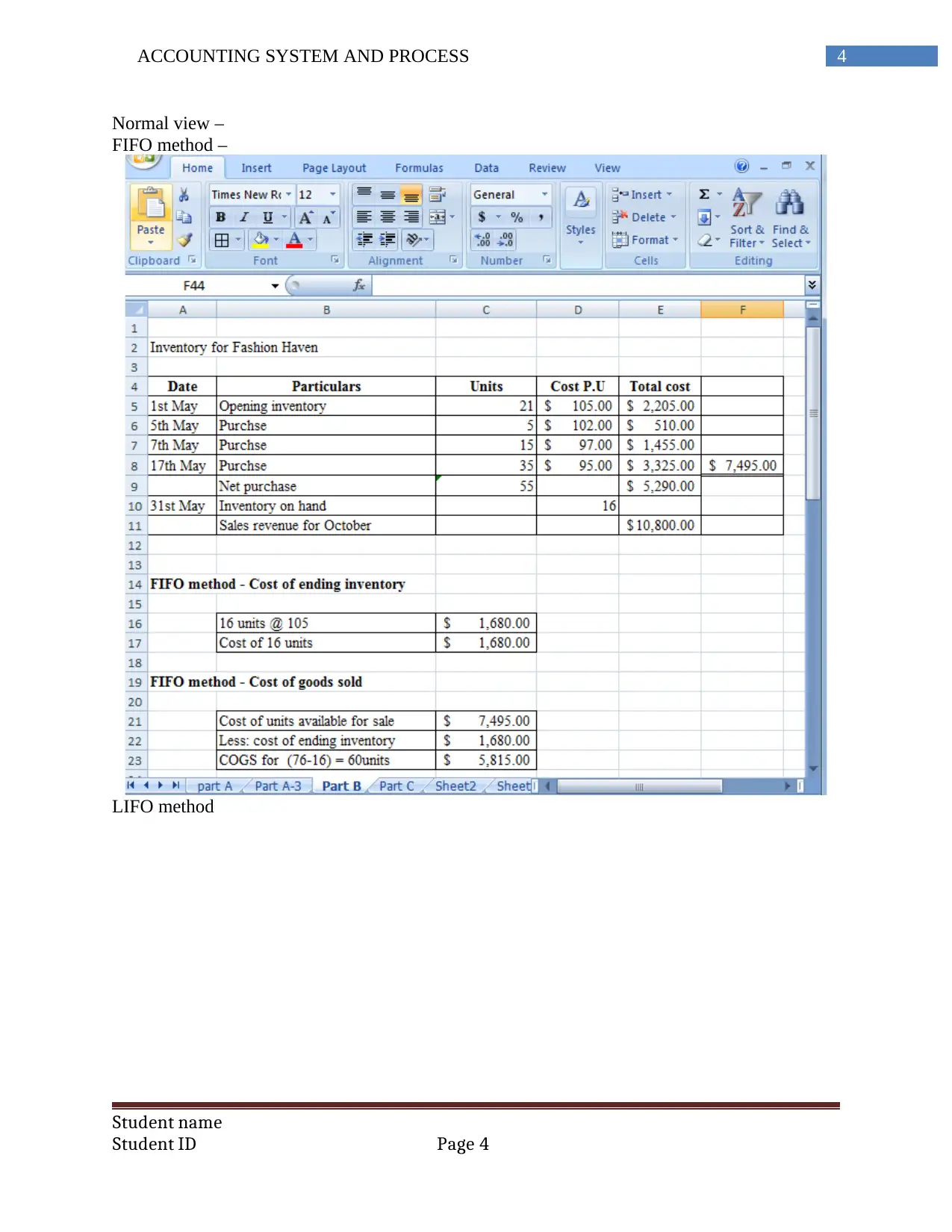
4ACCOUNTING SYSTEM AND PROCESS
Normal view –
FIFO method –
LIFO method
Student name
Student ID Page 4
Normal view –
FIFO method –
LIFO method
Student name
Student ID Page 4
Paraphrase This Document
Need a fresh take? Get an instant paraphrase of this document with our AI Paraphraser
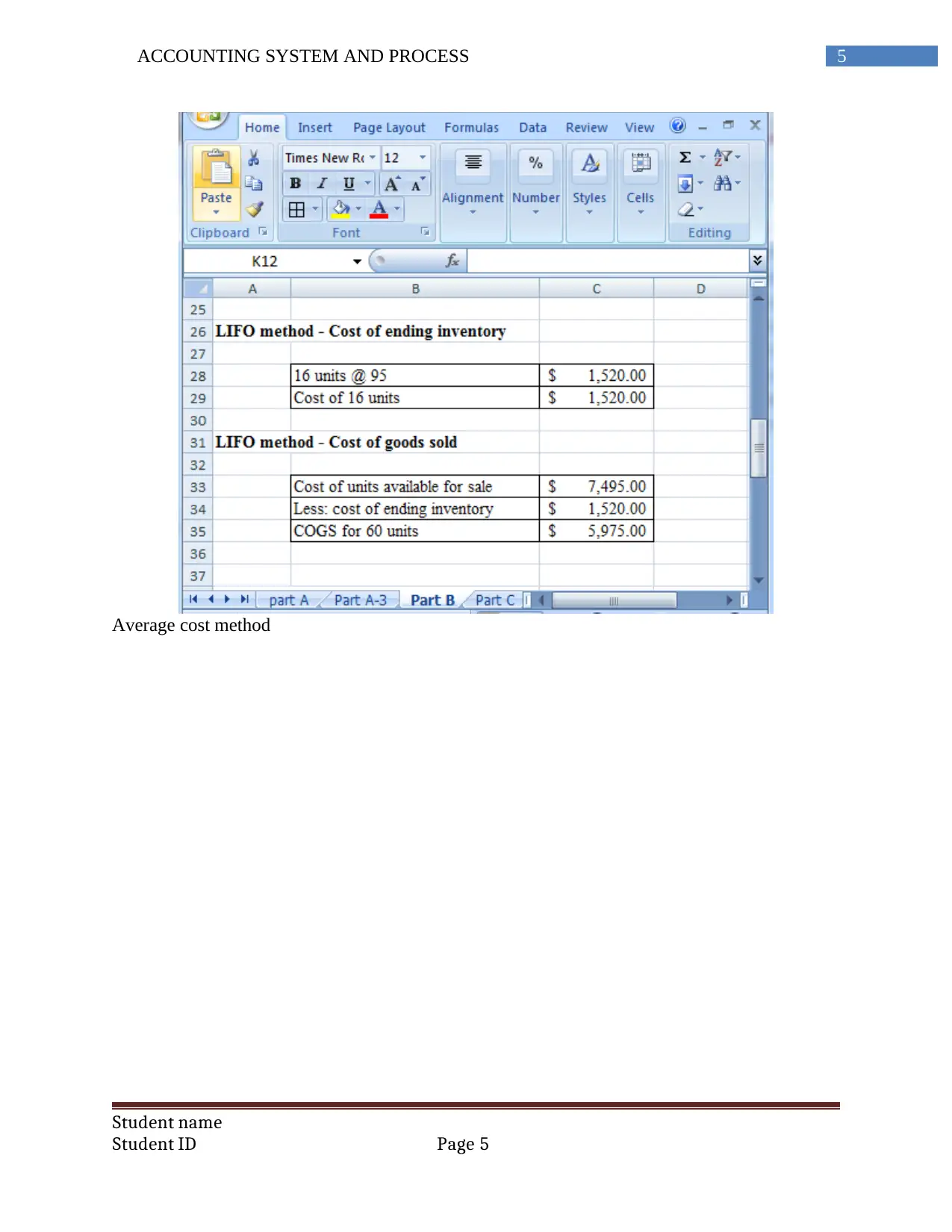
5ACCOUNTING SYSTEM AND PROCESS
Average cost method
Student name
Student ID Page 5
Average cost method
Student name
Student ID Page 5
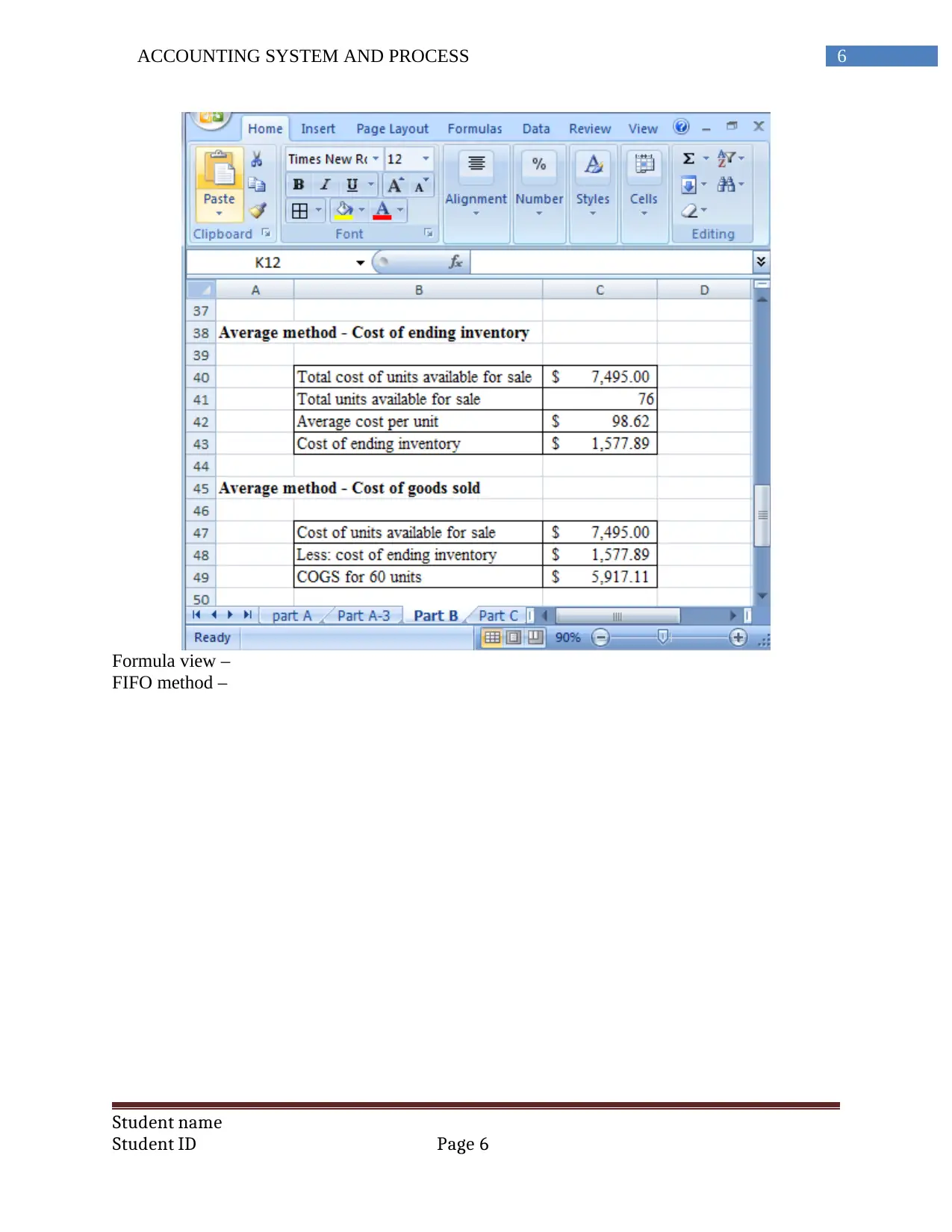
6ACCOUNTING SYSTEM AND PROCESS
Formula view –
FIFO method –
Student name
Student ID Page 6
Formula view –
FIFO method –
Student name
Student ID Page 6
⊘ This is a preview!⊘
Do you want full access?
Subscribe today to unlock all pages.

Trusted by 1+ million students worldwide
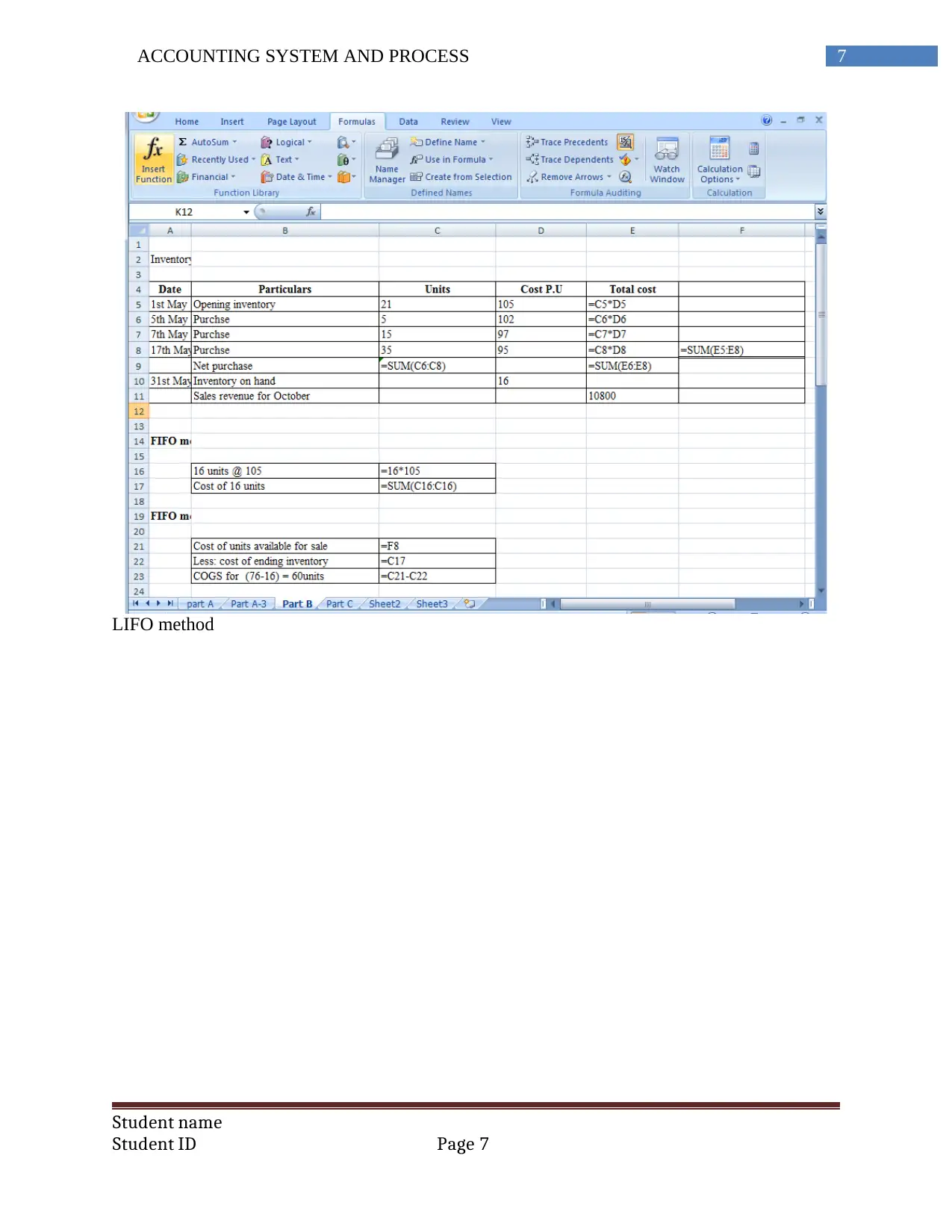
7ACCOUNTING SYSTEM AND PROCESS
LIFO method
Student name
Student ID Page 7
LIFO method
Student name
Student ID Page 7
Paraphrase This Document
Need a fresh take? Get an instant paraphrase of this document with our AI Paraphraser
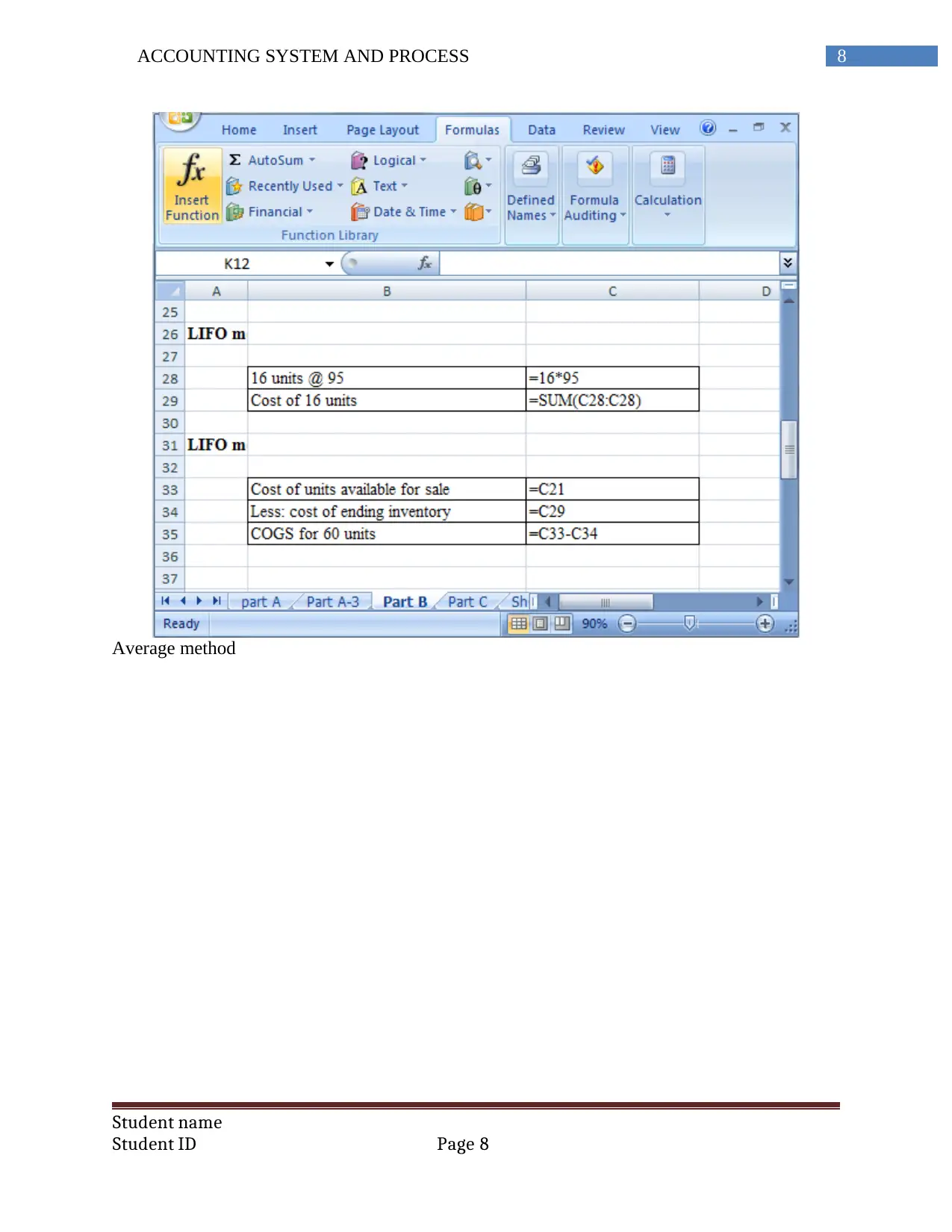
8ACCOUNTING SYSTEM AND PROCESS
Average method
Student name
Student ID Page 8
Average method
Student name
Student ID Page 8
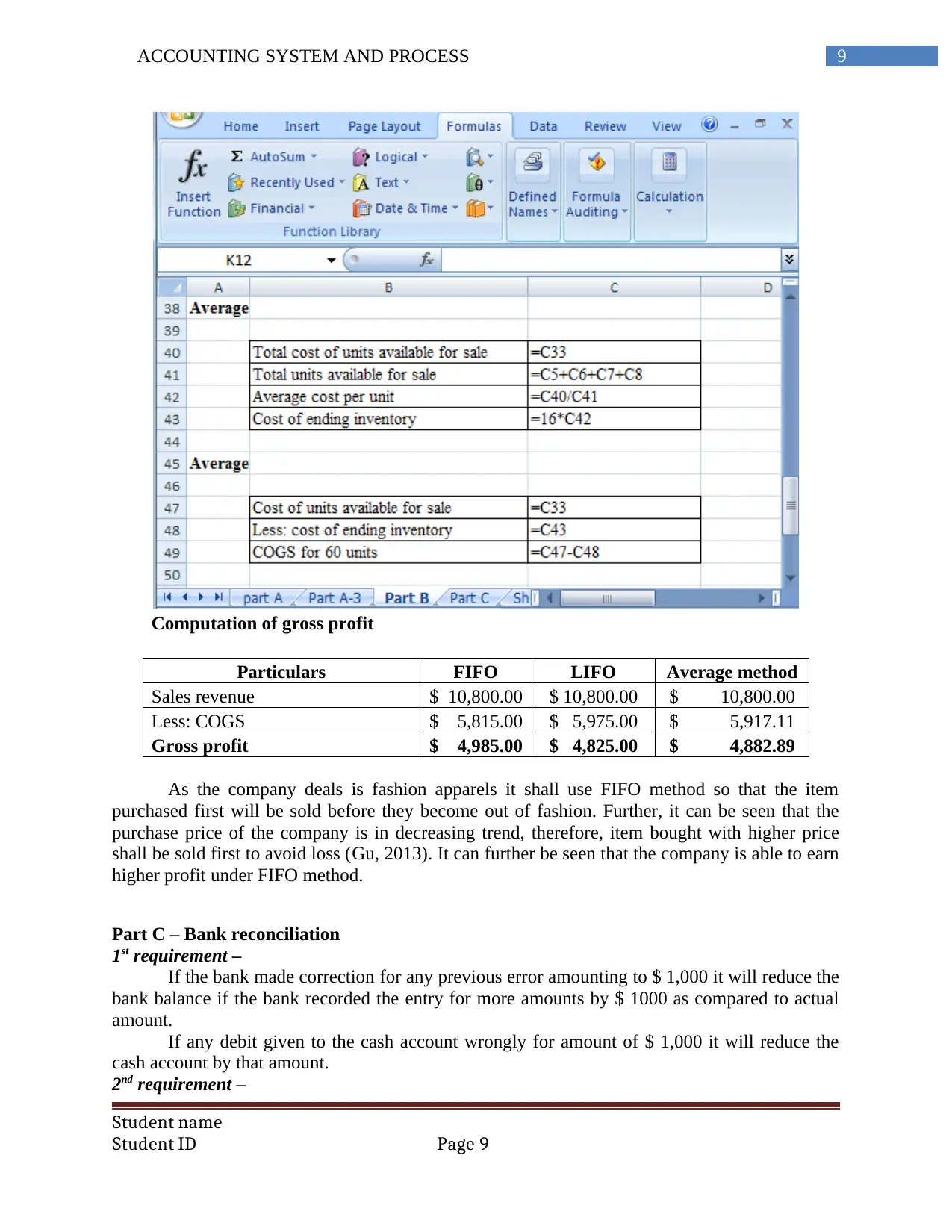
9ACCOUNTING SYSTEM AND PROCESS
Computation of gross profit
Particulars FIFO LIFO Average method
Sales revenue $ 10,800.00 $ 10,800.00 $ 10,800.00
Less: COGS $ 5,815.00 $ 5,975.00 $ 5,917.11
Gross profit $ 4,985.00 $ 4,825.00 $ 4,882.89
As the company deals is fashion apparels it shall use FIFO method so that the item
purchased first will be sold before they become out of fashion. Further, it can be seen that the
purchase price of the company is in decreasing trend, therefore, item bought with higher price
shall be sold first to avoid loss (Gu, 2013). It can further be seen that the company is able to earn
higher profit under FIFO method.
Part C – Bank reconciliation
1st requirement –
If the bank made correction for any previous error amounting to $ 1,000 it will reduce the
bank balance if the bank recorded the entry for more amounts by $ 1000 as compared to actual
amount.
If any debit given to the cash account wrongly for amount of $ 1,000 it will reduce the
cash account by that amount.
2nd requirement –
Student name
Student ID Page 9
Computation of gross profit
Particulars FIFO LIFO Average method
Sales revenue $ 10,800.00 $ 10,800.00 $ 10,800.00
Less: COGS $ 5,815.00 $ 5,975.00 $ 5,917.11
Gross profit $ 4,985.00 $ 4,825.00 $ 4,882.89
As the company deals is fashion apparels it shall use FIFO method so that the item
purchased first will be sold before they become out of fashion. Further, it can be seen that the
purchase price of the company is in decreasing trend, therefore, item bought with higher price
shall be sold first to avoid loss (Gu, 2013). It can further be seen that the company is able to earn
higher profit under FIFO method.
Part C – Bank reconciliation
1st requirement –
If the bank made correction for any previous error amounting to $ 1,000 it will reduce the
bank balance if the bank recorded the entry for more amounts by $ 1000 as compared to actual
amount.
If any debit given to the cash account wrongly for amount of $ 1,000 it will reduce the
cash account by that amount.
2nd requirement –
Student name
Student ID Page 9
⊘ This is a preview!⊘
Do you want full access?
Subscribe today to unlock all pages.

Trusted by 1+ million students worldwide
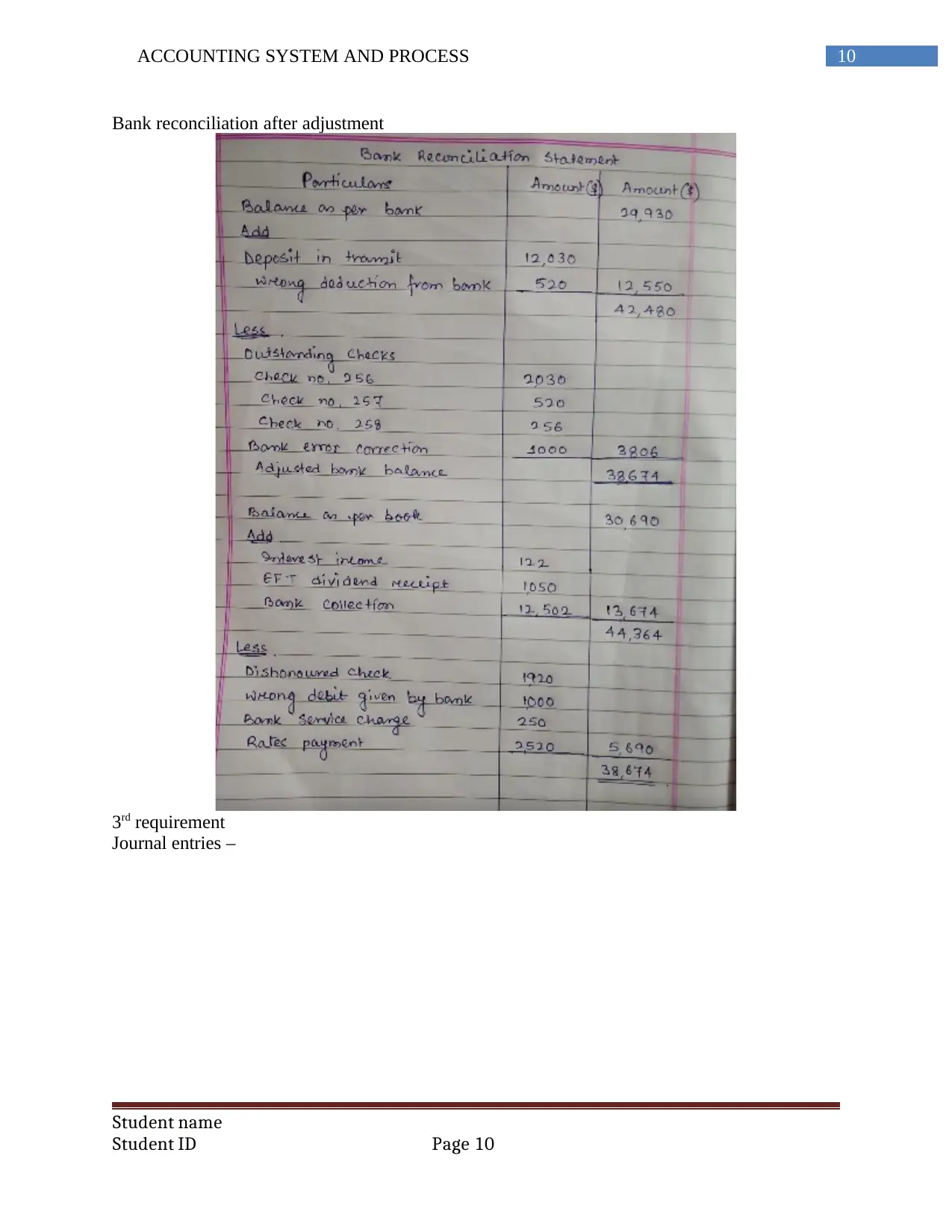
10ACCOUNTING SYSTEM AND PROCESS
Bank reconciliation after adjustment
3rd requirement
Journal entries –
Student name
Student ID Page 10
Bank reconciliation after adjustment
3rd requirement
Journal entries –
Student name
Student ID Page 10
Paraphrase This Document
Need a fresh take? Get an instant paraphrase of this document with our AI Paraphraser
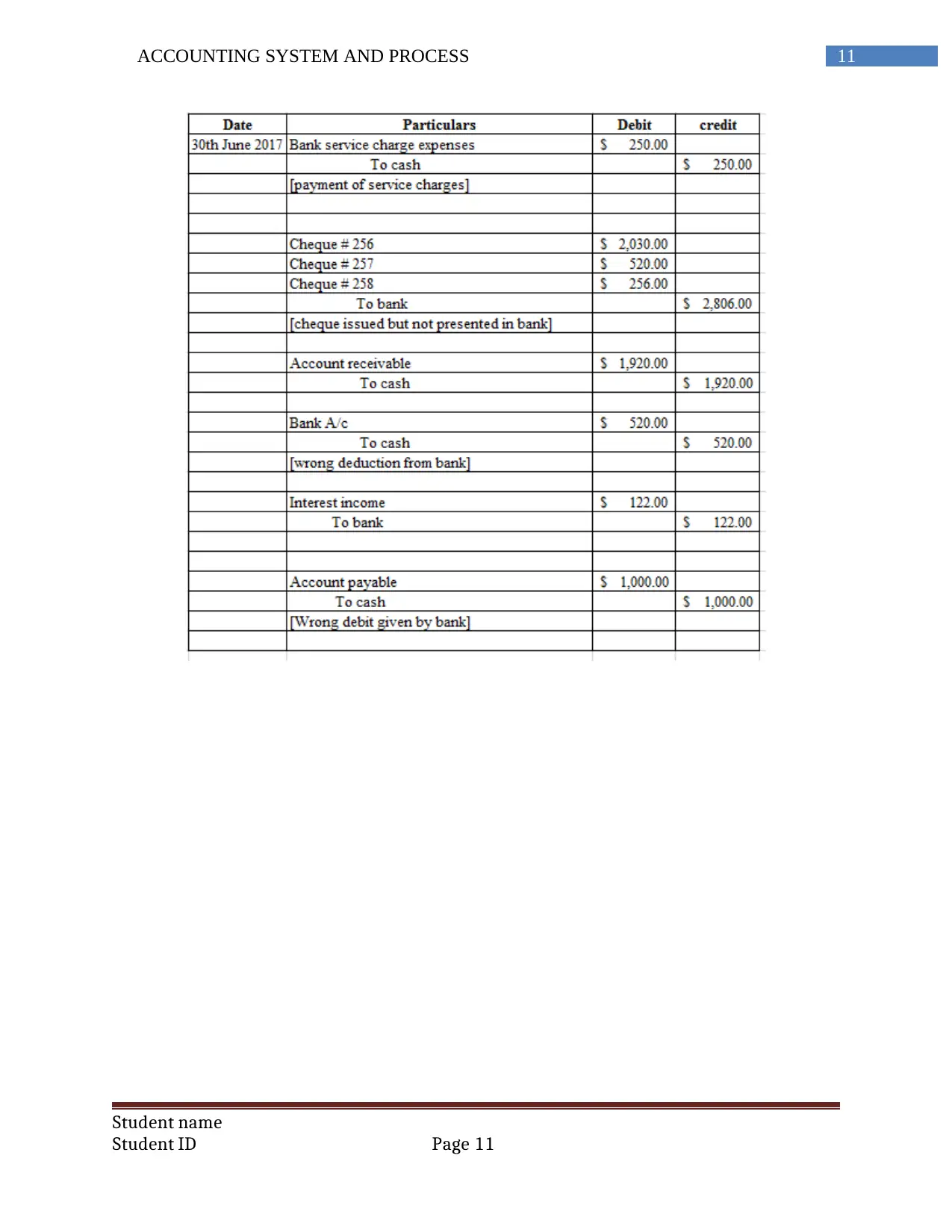
11ACCOUNTING SYSTEM AND PROCESS
Student name
Student ID Page 11
Student name
Student ID Page 11
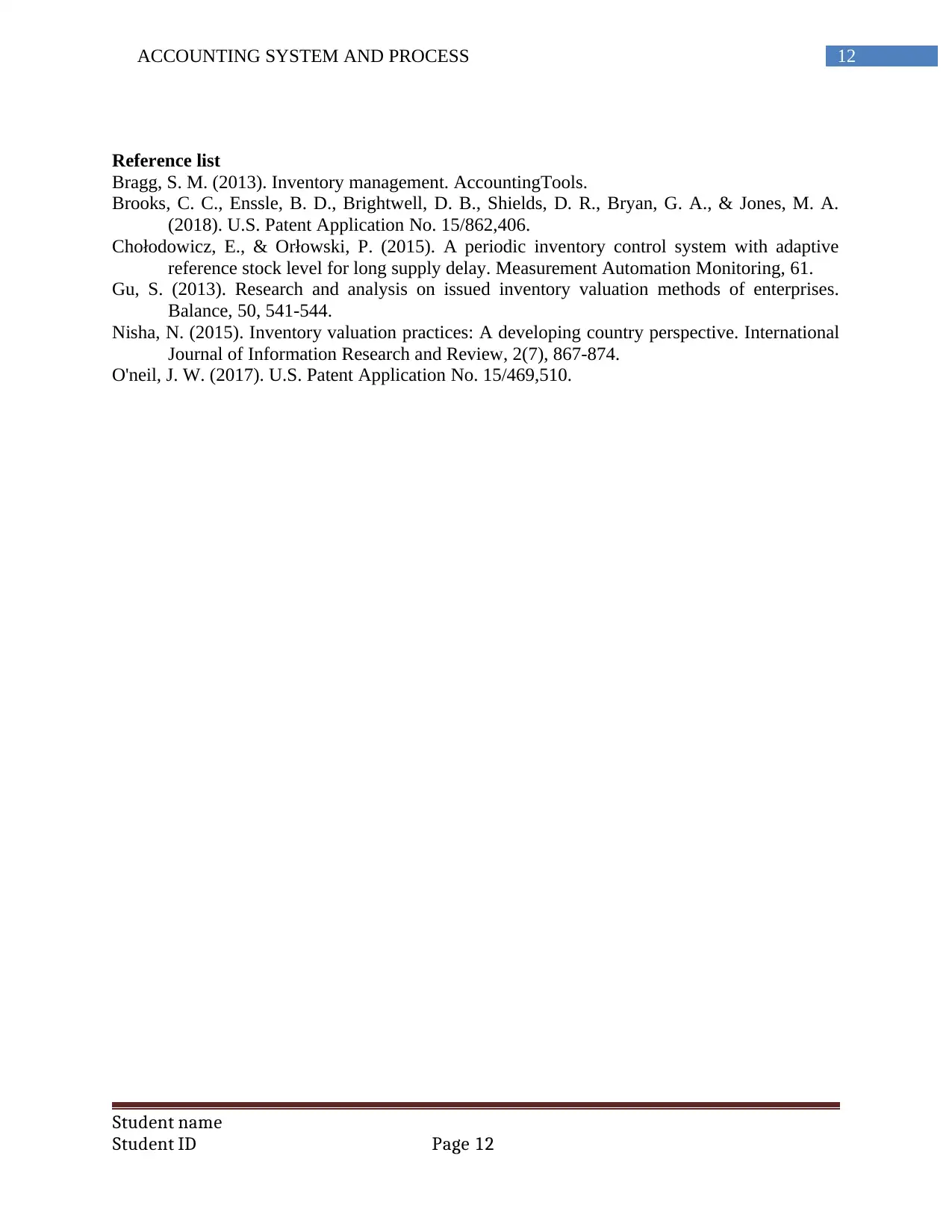
12ACCOUNTING SYSTEM AND PROCESS
Reference list
Bragg, S. M. (2013). Inventory management. AccountingTools.
Brooks, C. C., Enssle, B. D., Brightwell, D. B., Shields, D. R., Bryan, G. A., & Jones, M. A.
(2018). U.S. Patent Application No. 15/862,406.
Chołodowicz, E., & Orłowski, P. (2015). A periodic inventory control system with adaptive
reference stock level for long supply delay. Measurement Automation Monitoring, 61.
Gu, S. (2013). Research and analysis on issued inventory valuation methods of enterprises.
Balance, 50, 541-544.
Nisha, N. (2015). Inventory valuation practices: A developing country perspective. International
Journal of Information Research and Review, 2(7), 867-874.
O'neil, J. W. (2017). U.S. Patent Application No. 15/469,510.
Student name
Student ID Page 12
Reference list
Bragg, S. M. (2013). Inventory management. AccountingTools.
Brooks, C. C., Enssle, B. D., Brightwell, D. B., Shields, D. R., Bryan, G. A., & Jones, M. A.
(2018). U.S. Patent Application No. 15/862,406.
Chołodowicz, E., & Orłowski, P. (2015). A periodic inventory control system with adaptive
reference stock level for long supply delay. Measurement Automation Monitoring, 61.
Gu, S. (2013). Research and analysis on issued inventory valuation methods of enterprises.
Balance, 50, 541-544.
Nisha, N. (2015). Inventory valuation practices: A developing country perspective. International
Journal of Information Research and Review, 2(7), 867-874.
O'neil, J. W. (2017). U.S. Patent Application No. 15/469,510.
Student name
Student ID Page 12
⊘ This is a preview!⊘
Do you want full access?
Subscribe today to unlock all pages.

Trusted by 1+ million students worldwide
1 out of 12
Related Documents
Your All-in-One AI-Powered Toolkit for Academic Success.
+13062052269
info@desklib.com
Available 24*7 on WhatsApp / Email
![[object Object]](/_next/static/media/star-bottom.7253800d.svg)
Unlock your academic potential
Copyright © 2020–2025 A2Z Services. All Rights Reserved. Developed and managed by ZUCOL.




